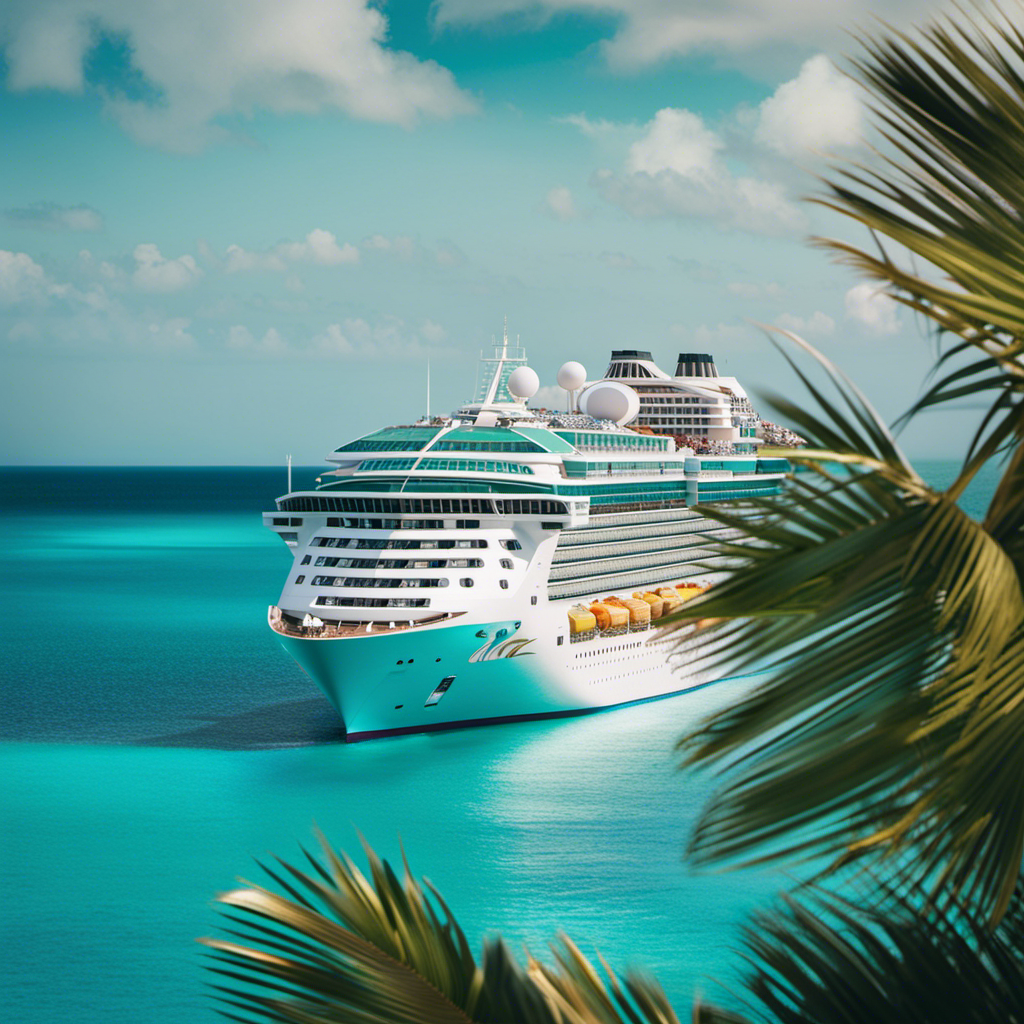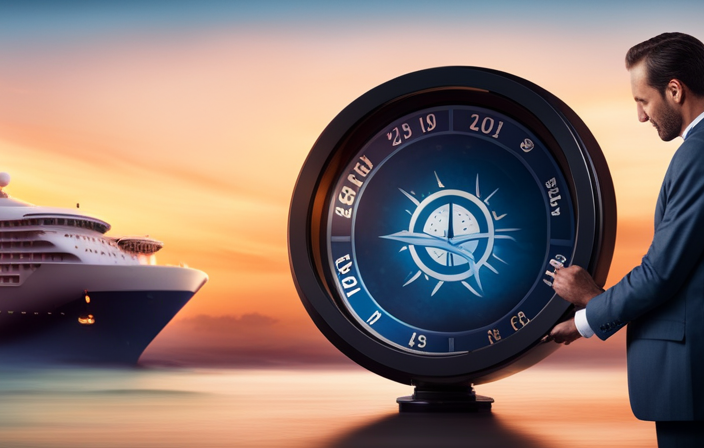As an individual with a deep love for exploration, the thought of setting sail on a cruise ship, uncovering new destinations while indulging in the luxurious amenities onboard, has consistently fascinated me.
But the burning question that often lingers in my mind is, ‘How much does an average cruise cost?’
In this article, we’ll dive into the various factors that influence cruise pricing, the different types of cruises and their corresponding costs, as well as provide tips and tricks on how to budget and save money on your next cruise adventure.
Get ready to set sail on a voyage of discovery!
Key Takeaways
- The cost of a cruise is influenced by factors such as destination, duration, type of cabin chosen, cruise line, time of year, and additional amenities.
- There is a wide range of cruise options available for every budget and preference, with the average cost per person per day ranging from $100 to $200.
- Accommodation prices on a cruise vary based on factors like cruise line, ship, cabin size, and destination, with interior cabins being the most affordable and suites being the most expensive.
- Dining expenses on a cruise can be managed by opting for included meals, utilizing room service, and packing snacks for shore excursions. Specialty restaurants may charge an additional fee.
Cruise Pricing Factors
There are several factors that can affect the cost of a cruise. When it comes to cruise pricing comparison, it’s important to consider these factors.
First, the destination plays a significant role. Popular destinations like the Caribbean or Mediterranean tend to have higher prices compared to lesser-known ones.
The duration of the cruise is another factor to consider. Longer cruises usually come with a higher price tag.
Additionally, the type of cabin you choose can impact the cost. Suites and balcony cabins are generally more expensive than interior or ocean view cabins.
Other factors that affect cruise prices include the cruise line, time of year, and any additional amenities or onboard activities.
Now, let’s explore the different types of cruises and their costs.
Types of Cruises and Their Costs
When it comes to types of cruises and their prices, you’ll find a wide range of options available. Whether you’re planning a family vacation or looking for a luxurious getaway, there’s a cruise for every budget and preference.
Here are three types of cruises and their costs:
-
Cruises for families: If you’re traveling with kids, many cruise lines offer family-friendly options that include kids clubs, entertainment, and activities for all ages. These cruises tend to be more affordable, with prices starting at around $500 per person for a week-long cruise.
-
Luxury cruise options: If you’re looking for a more upscale experience, luxury cruises are the way to go. These cruises offer top-notch amenities, gourmet dining, and personalized service. Prices for luxury cruises can range from $2,000 to $10,000 or more per person, depending on the length of the cruise and the level of luxury.
-
Specialty cruises: Some cruise lines offer specialty cruises tailored to specific interests, such as food and wine, adventure, or wellness. These cruises often come at a premium price due to the specialized experiences and unique itineraries they offer.
Now, let’s delve into the average cost of accommodation on a cruise.
Average Cost of Accommodation on a Cruise
If you’re considering booking accommodations on a cruise, you’ll find a range of options available to suit your preferences and budget. When it comes to the cost of cabins, pricing comparisons can help you make an informed decision.
The price of a cabin on a cruise can vary depending on several factors, including the cruise line, the ship, the size of the cabin, and the destination. Generally, interior cabins are the most affordable option, followed by oceanview cabins, balcony cabins, and finally, suites which tend to be the most expensive.
It’s important to note that prices can fluctuate depending on the time of year and demand. By comparing prices and considering your needs, you can find a cabin that fits your budget without compromising on comfort or amenities.
Speaking of expenses, let’s talk about dining expenses on a cruise.
Dining Expenses on a Cruise
To manage your dining expenses on a cruise, you’ll have options like dining in the main dining room, which is typically included in your fare, or dining at specialty restaurants for an additional fee. Here are some dining options on a cruise and tips for saving money on dining expenses:
- Main Dining Room: Enjoy a variety of delicious dishes in a formal setting with attentive service.
- Buffet: Indulge in a wide range of cuisines and satisfy your cravings at the self-serve buffet.
- Room Service: Treat yourself to a meal in the comfort of your own cabin, available 24/7.
- Specialty Restaurants: Experience gourmet dining with unique menus and intimate atmospheres.
- Casual Eateries: Grab a quick bite at the poolside grill or pizzeria.
To save money on dining expenses, consider these tips: opt for the main dining room or buffet instead of specialty restaurants, take advantage of included room service, and pack snacks and drinks for shore excursions. By being mindful of your choices, you can enjoy delicious meals while keeping your budget in check.
Now, let’s explore some additional onboard costs to consider.
Additional Onboard Costs to Consider
When planning a cruise vacation, it’s important to consider not only the upfront cost but also the hidden onboard expenses that can quickly add up.
From specialty dining and drink packages to spa treatments and shore excursions, these extras can significantly impact your budget.
In this discussion, we will explore the various hidden onboard expenses to be aware of, as well as provide tips on how to budget for these extras without breaking the bank.
Hidden Onboard Expenses
Be aware of the hidden expenses that can increase the total cost of your cruise. While the initial price of the cruise may seem reasonable, there are often additional fees and charges that can catch you off guard. Here are some hidden expenses to keep in mind:
-
Gratuities: Many cruise lines automatically add gratuities to your bill, so be sure to factor this into your budget.
-
Specialty Dining: While meals in the main dining room are usually included, specialty restaurants often come with an extra charge.
-
Onboard Activities: Some activities and amenities, such as spa treatments or fitness classes, may come with an additional fee.
These hidden fees and unexpected charges can quickly add up, so it’s important to budget accordingly. As you plan for your cruise, be sure to account for these extras to avoid any unpleasant surprises.
Budgeting for Extras
Make sure you factor in the cost of specialty dining and onboard activities when budgeting for extras on your cruise. While your cruise fare may cover the basics, there are additional expenses to consider.
Cruise excursion expenses can add up quickly, especially if you choose to participate in multiple excursions during your trip. These excursions often offer unique experiences and opportunities to explore the ports of call, but they come at a price.
Additionally, entertainment costs can also contribute to your overall expenses. From Broadway-style shows to comedy clubs and live music performances, there is no shortage of entertainment options onboard. These activities can provide hours of enjoyment, but they may come with an additional fee.
Now that you are aware of these potential costs, let’s explore some tips for budgeting your cruise expenses.
Tips for Budgeting Your Cruise Expenses
Planning your cruise expenses can be easier when you take advantage of budgeting tips. Here are some budgeting strategies and saving tips that can help you make the most of your cruise experience:
-
Track your expenses: Keeping a record of your spending can help you identify areas where you can cut back and save.
-
Set a daily budget: Determine how much you want to spend each day on meals, activities, and souvenirs to avoid overspending.
-
Research excursion costs: Look into the cost of shore excursions and plan accordingly. Some may be included in your package, while others may require an additional fee.
-
Take advantage of onboard activities: Many cruises offer free or low-cost activities onboard, such as fitness classes or movie nights. Make the most of these options to save money.
By implementing these budgeting strategies and saving tips, you can better plan your cruise expenses and make sure you have a memorable vacation without breaking the bank.
Now, let’s explore some ways to save money on a cruise.
Ways to Save Money on a Cruise
Maximize your savings by taking advantage of discounted package deals and promotions offered by the cruise line. When booking a cruise, it’s always a good idea to plan ahead and look for ways to save money. Here are some tips for booking in advance and finding discounted cruise packages:
-
Research and compare prices from different cruise lines. Some may offer better deals or promotions than others.
-
Book during off-peak seasons or shoulder seasons when prices are lower.
-
Consider booking a repositioning cruise, where the ship is relocating to a different region. These cruises tend to be cheaper.
-
Look for last-minute deals or flash sales, but be prepared to be flexible with your travel dates and destinations.
-
Join loyalty programs or sign up for newsletters to receive exclusive offers and discounts.
Frequently Asked Questions
Are Gratuities Included in the Cruise Fare?
Gratuities are not always included in the cruise fare. Each cruise line has its own tipping policy, so it’s important to check before booking. To calculate gratuities, consider the daily rate per person and the length of your cruise.
Are Alcoholic Beverages Included in the Cruise Package?
Yes, alcoholic beverages are usually not included in the cruise package. However, there are non-alcoholic beverage options available. The average prices for alcoholic beverages on a cruise vary, but they can be quite expensive.
Are There Any Hidden Fees or Charges That I Should Be Aware Of?
There are some additional costs to consider when budgeting for a cruise. It’s important to be aware of any hidden fees that may arise during your trip. Here are some budgeting tips to help you plan accordingly.
Can I Bring My Own Food and Drinks on Board to Save Money?
Yes, you can bring your own food and drinks on board a cruise to save money. It’s a great cost-saving tip! Bringing personal snacks and drinks will help you avoid additional expenses during your trip.
Are There Any Special Discounts or Promotions Available for Certain Groups, Such as Seniors or Military Personnel?
Yes, there are special discounts and promotions available for certain groups, such as seniors or military personnel. These discounts can help save money on your cruise and make it even more affordable and enjoyable.
Conclusion
In conclusion, taking a cruise can be an incredible experience that allows you to explore different destinations while enjoying the comfort and luxury of a floating hotel.
However, it’s important to be aware of the potential costs involved. From the price of accommodation and dining expenses to additional onboard costs, it’s essential to budget wisely.
By being mindful of your expenses and exploring ways to save money, you can embark on a memorable cruise without breaking the bank.
So set sail and let the waves of euphoria and excitement wash over you as you embark on your next adventure at sea.










